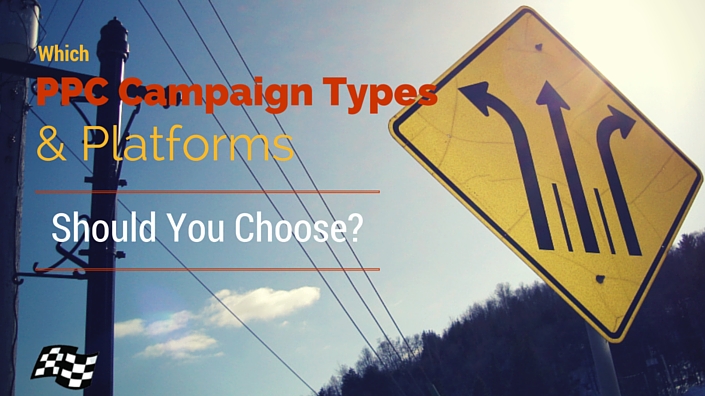You’ve got an online advertising budget. You want more of the right customers. But where should you go first, second and third? There are so many options available that it can be overwhelming, even for someone like me who follows the industry day in and day out. What platform should you choose? What kind of campaign should you choose? I’m here to help answer those questions.
I’m going to provide you with a general overview of the current campaign options available through the different PPC platforms. In this post, I’ll start with the search vendor platforms. Note: This is not meant to be a comprehensive look at each campaign type. It’s simply meant to give you some direction for what’s at your disposal and which options might be the best fit for your business. After getting a general feeling for these, you should dive deeper into researching proper set up and good strategy for each.
Search Network Campaigns
These types of PPC ads are displayed among the results when someone enters a query on a search engine, such as Google. These are often the types of ads that people most often think of when they think of PPC, but as you will see, these go beyond the text ads that you see at the top and right side of search results.
Search Text Ad Campaigns
 What they are: This is where a lot of businesses will start with PPC advertising since searchers are actively looking for what they’re offering. Because searchers are typically toward the end of the buying funnel, the ROI for these campaigns tends to be better than other forms of advertising that interrupt the target audience.
What they are: This is where a lot of businesses will start with PPC advertising since searchers are actively looking for what they’re offering. Because searchers are typically toward the end of the buying funnel, the ROI for these campaigns tends to be better than other forms of advertising that interrupt the target audience.
- Primarily good for . . . businesses that offer a product or service web users are searching for.
- Primary business objective: Conversions
- Target: Searchers who type queries into search engines
- Ad type: Text ads
- Where ads appear: On search results pages (SERPs), including search partners (like AOL), if chosen
- Common success metrics: Sales/Leads, Cost Per Conversion, Return-on-Ad-Spend (ROAS)
- Available platforms: Google AdWords and Bing Ads
Shopping Campaigns
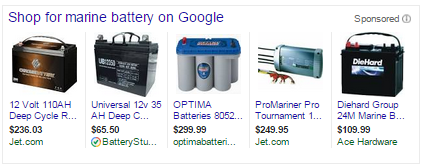 What they are: These campaigns control the Product Listing Ads you see on Google Search properties. Ecommerce sites should have a goal of first dominating this advertising space. Because these ads have the ability to show images of specific products searchers are looking for, they tend to have the best ROI for ecommerce businesses.
What they are: These campaigns control the Product Listing Ads you see on Google Search properties. Ecommerce sites should have a goal of first dominating this advertising space. Because these ads have the ability to show images of specific products searchers are looking for, they tend to have the best ROI for ecommerce businesses.- Primarily good for . . . ecommerce businesses.
- Primary business objective: Conversions
- Targeting: Searchers who type in queries into search engines
- Ad type: Product listing ads
- Where ads appear: On search results pages (SERPs), including Shopping engine results
- Common Success Metrics: Transactions, Cost Per Transaction, ROAS
- Available platforms: Google AdWords and Bing Ads
Dynamic Search Ad Campaigns
 What they are: This campaign option was built for advertisers who already have Search text ads running but would like to expand their reach and find new keywords that convert. The PPC platform reads the content on chosen web pages and matches the content on the page with searches that you’re not already targeting in other campaigns. It then serves a dynamic ad which has a headline that is generated based on the search query performed and the landing page you’ve chosen.
What they are: This campaign option was built for advertisers who already have Search text ads running but would like to expand their reach and find new keywords that convert. The PPC platform reads the content on chosen web pages and matches the content on the page with searches that you’re not already targeting in other campaigns. It then serves a dynamic ad which has a headline that is generated based on the search query performed and the landing page you’ve chosen.- Primarily good for . . . businesses that want to expand their reach in search.
- Primary business objective: Conversions, finding new keywords that convert
- Targeting: Searchers who type in queries into search engines
- Ad type: Dynamic search text ads
- Where ads appear: On search results pages (SERPs), including search partners (like AOL) if chosen (Google only)
- Common Success Metrics: Clicks, Conversions
- Available platforms: Google AdWords
Call-only Campaigns
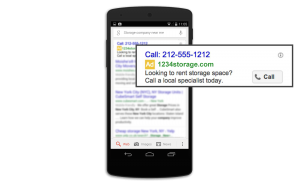 What they are: For many businesses, customers may not need to go to their website. When they search, they do so with the intention of calling the business. For example, ordering a pizza or getting an emergency plumber. For these types of businesses, making users click through to the website to find your phone number to call is asking them to do unnecessary steps. These ads don’t give searchers the option to click through to the website. They only give the option to call your business.
What they are: For many businesses, customers may not need to go to their website. When they search, they do so with the intention of calling the business. For example, ordering a pizza or getting an emergency plumber. For these types of businesses, making users click through to the website to find your phone number to call is asking them to do unnecessary steps. These ads don’t give searchers the option to click through to the website. They only give the option to call your business.- Primarily good for . . . businesses where the primary conversion action is for customers to call the business.
- Primary business objective: Phone calls
- Targeting: Searchers who type queries into search engines on mobile devices
- Ad type: Call-only ads
- Where ads appear: On mobile search results pages, including search partners (like AOL) if chosen (Google only)
- Common Success Metrics: Phone Calls, Cost Per Call, ROAS
- Available platforms: Google AdWords
Mobile App Campaigns (Search Network)
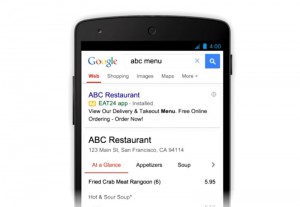 What they are: If a user does a query that your app can provide the answer for, you can show them an ad that encourages them to download your app or takes them to a specific landing spot in your app that has the answer if they already have your app downloaded.
What they are: If a user does a query that your app can provide the answer for, you can show them an ad that encourages them to download your app or takes them to a specific landing spot in your app that has the answer if they already have your app downloaded.
- Primarily good for . . . connecting with mobile searchers.
- Primary business objective: App downloads and engagement
- Targeting: Mobile searchers who use queries relevant to your app
- Ad type: App install ads and App engagement ads
- Where ads appear: Mobile search results
- Common Success Metrics: Conversions, Cost Per Conversion, ROAS, User Loyalty/Recency
- Available platforms: Google AdWords
Video Campaigns (Search Network)
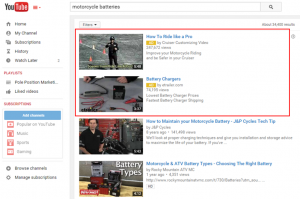 What they are: These are video ads that can appear in search results on YouTube. You pay when a user watches 30 seconds of your video (or the duration if it’s shorter than 30 seconds) or engages in other video interactions, such as clicks on the call-to-action overlays (CTAs), cards or companion banners.
What they are: These are video ads that can appear in search results on YouTube. You pay when a user watches 30 seconds of your video (or the duration if it’s shorter than 30 seconds) or engages in other video interactions, such as clicks on the call-to-action overlays (CTAs), cards or companion banners.
- Primarily good for . . . connecting with YouTube users who perform searches that are relevant to your video content.
- Primary business objective: Branding, Conversions
- Targeting: Web users who search for videos with keywords
- Ad type: Trueview in-display ads
- Where ads appear: YouTube
- Common Success Metrics: Views, Cost Per View, Engagements, Cost Per Engagement
- Available platforms: Google AdWords
Display Network Campaigns
These ads appear on websites that contain ads such as blogs and newspaper sites. Therefore, the ads show up based on the website’s relevance to your product or service rather than a specific term that the visitor is searching on. This obviously is a more passive audience that may not be in the market for what you are selling, but Display Network Campaigns can help you boost awareness of your business.
Remarketing Campaigns
 What they are: These campaigns that allow you to show ads to web users on web properties after they’ve been to your website. When built and optimized efficiently, they are known to get some of the best ROI of all campaign types because the users you’re targeting are familiar with your brand and are somewhere in the buying funnel.
What they are: These campaigns that allow you to show ads to web users on web properties after they’ve been to your website. When built and optimized efficiently, they are known to get some of the best ROI of all campaign types because the users you’re targeting are familiar with your brand and are somewhere in the buying funnel.- Primarily good for . . . all businesses, but particularly businesses with longer sales cycles. The ability to get in front of your customers multiple times during their buying process makes them more likely to choose you when the time is right.
- Primary business objective: Awareness or conversions
- Targeting. Web users who consume content on web properties that show Google ads
- Ad type: Text, image, rich media and video ads
- Where ads appear: Display Network sites and apps
- Common success metrics: Downloads/Sign ups/Leads, View-through Conversions, Cost Per Impression
- Available platforms: Google AdWords and Bing Ads
Dynamic Remarketing Campaigns
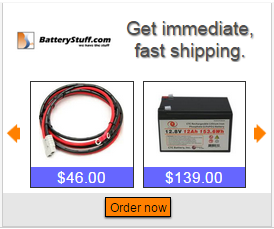 What they are: These are remarketing campaigns, but the products shown in the ads are dynamically inserted according to the products the viewer of the ad previously viewed on your site.
What they are: These are remarketing campaigns, but the products shown in the ads are dynamically inserted according to the products the viewer of the ad previously viewed on your site.- Primarily good for . . . ecommerce businesses. The ads work off of ecommerce product data feeds to determine the products and details that get inserted into the ad.
- Primary business objective. Conversions
- Targeting: Web users who consume content on web properties that show Google ads
- Ad type: Text, image
- Where ads appear: Display Network sites and apps.
- Common success metrics: Conversions, Cost Per Conversion, ROAS
- Available platforms: Google AdWords
Display Campaigns
 What they are: Although these campaigns can drive conversions, they are best known for branding, or influencing your target audience. They can do this simply with their message or by persuading their customers to complete micro-conversions that will influence their purchasing decisions later on.
What they are: Although these campaigns can drive conversions, they are best known for branding, or influencing your target audience. They can do this simply with their message or by persuading their customers to complete micro-conversions that will influence their purchasing decisions later on.- Primarily good for . . . familiarizing web users with your brand by placing ads on reputable sites that are popular among your target audience. This exposure influences this audience to consider your brand when the timing is right for purchase.
- Primary business objective: Awareness or conversions
- Targeting: Web users who consume content on web properties that show Google ads
- Ad type: Text, image, rich media and video ads
- Where ads appear: Display Network sites and apps
- Common success metrics: Downloads/Sign ups/Leads, View-through Conversions, Cost Per Impression
- Available platforms: Google AdWords
Engagement Ad Campaigns
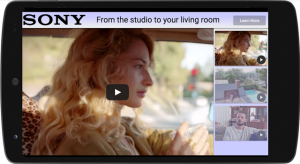 What they are: These are display campaigns but with different types of ad formats. Engagement ads fit in standard display ad units and load rich media content either within the ad or with an expanded canvas. They are considered engaged with when site users hover their mouse over the ad for at least two seconds (on computers), or they click on the ad (computers, mobile and tablets). These ads support full rich media capabilities, allowing you to embed many different types of content. They also allow social content to be promoted across the web. People can now comment and share your post from the ad.
What they are: These are display campaigns but with different types of ad formats. Engagement ads fit in standard display ad units and load rich media content either within the ad or with an expanded canvas. They are considered engaged with when site users hover their mouse over the ad for at least two seconds (on computers), or they click on the ad (computers, mobile and tablets). These ads support full rich media capabilities, allowing you to embed many different types of content. They also allow social content to be promoted across the web. People can now comment and share your post from the ad.
- Primarily good for . . . promoting brand content users can engage with like videos, your YouTube masthead, a digital catalog, a presentation, a livestream of an event and more.
- Primary business objective: Audience engagement
- Targeting: Web users who consume content on web properties that show Google ads
- Ad type: Lightbox, standard expandable and post ads
- Where ads appear: Display Network sites and apps
- Common success metrics: Engagements, Engagements Per Impression, Cost Per Engagement
- Available platforms: Google AdWords
Mobile App Campaigns (Display Network)
- What they are: If a user already has your app, you can show them ads on websites that encourage them to come back to your app to use it or perform a specific action with it.
- Primarily good for . . . connecting with mobile browsers who already have your app.
- Primary business objective: User engagement or conversion
- Targeting: Mobile web users
- Ad type: App engagement ads
- Where ads appear: Display Network sites and apps
- Common success metrics: Conversions, Cost Per Conversion, ROAS, User Loyalty/Recency
- Available platforms: Google AdWords
Video Campaigns (Display Network)
- What they are: These are video ads that can appear on websites throughout the Google Display Network. You pay when a user clicks your ad and begins watching your video.
- Primarily good for . . . connecting with YouTube users who perform searches that are relevant to your video content.
- Primary business objective: Branding, Conversions
- Targeting: Web users who search for videos with keywords
- Ad type: Trueview in-stream ads.
- Where ads appear: Display Network sites and apps
- Common success metrics: Views, Cost Per View, Engagements, Cost Per Engagement
- Available platforms: Google AdWords
Gmail Ad Campaigns
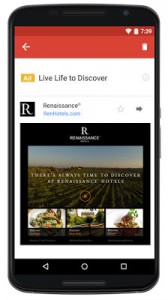 What they are: These are ads that show in Gmail based upon display campaign targeting options (keywords, topics, etc. They are not able to be used for remarketing yet.).
What they are: These are ads that show in Gmail based upon display campaign targeting options (keywords, topics, etc. They are not able to be used for remarketing yet.).- Primarily good for . . . connecting with web users who are talking about your product/service or who have the characteristics of your target market.
- Primary business objective: Branding, Conversions
- Targeting: Web users who use Gmail and show signs of being in your target audience.
- Ad type: Gmail ads. A collapsed ad shows that can be expanded with a click and saved or forwarded to others.
- Where ads appear: On mail.google.com only
- Common success metrics: Impressions, Conversions, Cost Per Impression, Cost Per Conversion
- Available platforms: Google AdWords.
Powerful Hybrids
Many of the campaign types above can be combined in creative ways to create more granular levels of reaching your target audience with your ads. Here are just a couple to think about to get your creative juices flowing:
- Remarketing for Search Ads (Google only): This campaign option allows you to combine the targeting of keywords and remarketing audiences. You target searchers who have already been to your site with text ads on search results pages when they’re searching. Because these searchers have been to your site recently, it’s assumed they are interested in what you offer. Therefore, you can target them more broadly with keywords when they perform searches. For example, if I offer recruiting software and someone came to my site and showed quality engagement with it, I may want to show them an ad when they search for anything related to recruiting, staffing, resumes or common competitor names. The fact that they’re searching for things related to what I’m offering is a good indicator that they’d be open to seeing my offer again.
- Remarketing for Dynamic Search Ads (Google only): This is a dynamic remarketing campaign for the search network. In other words, visitors who have already been to the site would search Google for a product and would then be presented with a dynamic search ad. This dynamic search ad’s headline would speak to the product, and the landing page would go to the most relevant product page. With this campaign type, we incorporate facets of dynamic search ads, remarketing for search and dynamic remarketing.
- Remarketing for Shopping Campaigns (Google only): This is a Shopping campaign that only targets specific remarketing audience lists. For example, let’s say you have a remarketing list of users who added at least one item to their cart but didn’t purchase before leaving your site. If they were to later search with keywords that match your products, you want to make sure you give them another chance. Sure, your normal Shopping campaign may show an ad here, but these searchers are more valuable than normal. By creating another campaign that only targets them, you can increase your bids dramatically to make sure you’re in prime position to earn their business.
That’s it . . . for now! It’s very likely this will all change by like, next week 🙂 I will try to keep this as up-to-date as possible. You may want to bookmark this for reference and check back when you’re trying to decide which direction to go with your marketing budget. I know I will be!

